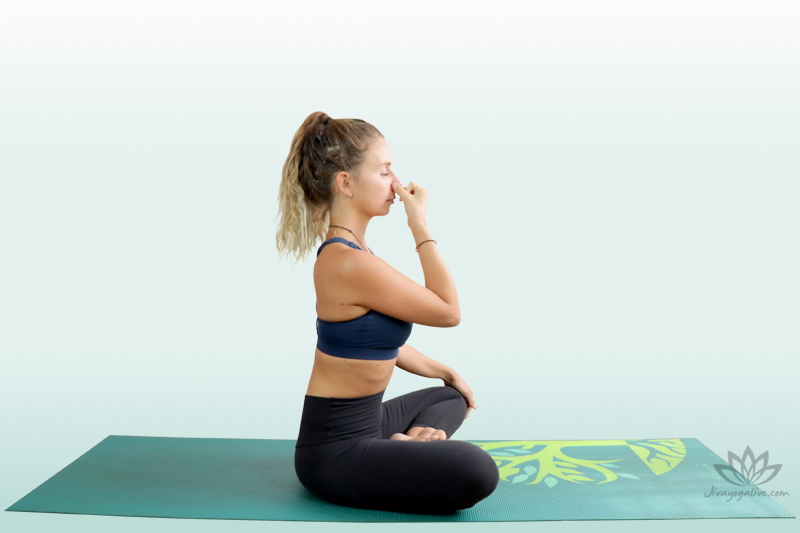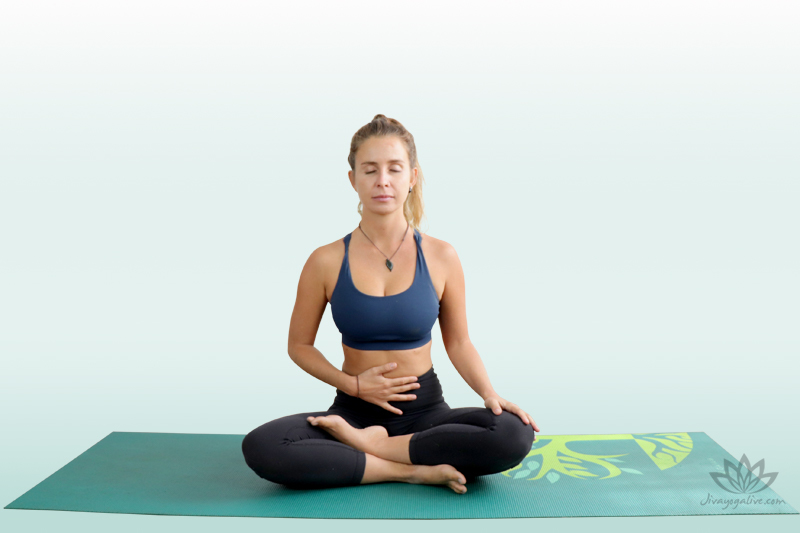It was a few years of practicing yoga before I stumbled across one of it’s biggest benefits – Pranayama.
I was already meditating regularly, but I would often be in a battle with my mind trying to shut off thoughts and getting frustrated when they would persist! Guided meditations were my jam for years. I didn’t really have a method of bringing the kind of focus that is required to go deep into stillness.
Then I was introduced to different types of Pranayama. My internal world changed. I was able to use these techniques to drop out of my head and connect me to a peace that lies behind the thoughts, and this is available to us all! On the physical side of things, I have also struggled with lifelong chronic asthma. Pranayama was a game changer for my lung capacity.
After practicing the Three Part Yogic breath for as little as ten rounds, I could feel the space in my chest open up and my breaths were much deeper! I hadn’t been aware of just how shallow my breathing was before. I realised I had been breathing through a straw my whole life!
Pranayama Benefits
- Relieves the symptoms of asthma
- Lower blood pressure and boosts circulation
- Good for migraines and digestive disorders
- Calms the central nervous system
- Improves lung capacity
The list of physical benefits goes on and on. However, my number one reason for practicing Pranayama diligently, is because of its ability to to create a bridge to connect me to that inherent stillness that is inside of us all!
All we ever have to in life is breathe. If we want to be at peace, all we have to do is breathe with awareness!
“When the Breath wanders, the mind is unsteady, but when the Breath is still, so is the mind still.” – Hatha Yoga Pradipika
7 Types Of Pranayama Infographic

1. Alternate Nostril Breathing – Nadi Shodhana Pranayama
- Take your right hand and curl the pointer and middle finger into the palm.
- Take the thumb over your right nostril and your ring finger over your left nostril.
- Block your right nostril with your thumb and inhale up your left for a count of four.
- Hold the breath for four.
- Now repeat on left side
In Ayurvedic medicine this technique is used to harmonise the two hemispheres of the brain, which balances the physical, mental and emotional aspects of your being. Nadi means “channel” or “flow”, and shodana translates as “purifying” or “cleansing”

2. Three-Part Yogic Breath – Dirga Pranayama
Your inhale wll be broken into three parts.
- First, inhale into the belly
- Then into the chest
- Lastly, into the collarbones
Hold the breath and relax, dropping the shoulder down away from the ears. Hold for as long as is comfortable.
Exhale completely, bringing the torso down, resting the hands on the floor, head can hang.
Hold the void (no breath), for as long as is comfortable and then repeat.
One of the more simple Pranayama techniques, making it a great place to start when exploring the world of Pranayama.
You are actively working to fill the body in three distinct parts, which invites more awareness of the sensation of breathing inside each part of the body.
After ten rounds or so, I always feel as though my lungs have doubled in size!

3. Breath of Fire – Kapalabhati Pranayama
Take your right hand to the belly inhale through the nose. As you exhale, suck the belly button back towards the spine. You focus on the exhales and pump the stomach in each time. The inhales will come naturally.
I recommend getting comfortable with the Three Part Yogic Breath before moving onto this slightly more advanced technique.
This Pranayama is effective at cleansing even the most remote parts of the body and the vigorous exhalations are great as dispelling toxins and waste.

4. Cooling Breath – Sitali Pranayama
Take the tongue and make the shape of a ‘U’, so like this. If that is not accessible, we can just make an ‘O’ shape with the mouth. Inhale through the mouth, then close the mouth. Exhale through the nose.
This Pranayama, invites moisture into the system which cools down the body and the mind. It’s great to bring in at the end of a particularly heated practice to counter internal heat and bring the body back into balance.

5. Equal Fluctuations – Sama Vritti Pranayama
- Breathing through the nose, inhale for a count for four and Hold for a count of four.
- Exhale for four and hold, for four. Over time you can work up to six, eight and so on.
This Pranayama can be practiced by anywhere in a way that is low key! It’s an effective way to focus the mind and cultivate stillness.

6. Humming Bee Breath – Bhramari Pranayama
- Close the lips but have the teeth slightly parted. The tongue is just resting on the back side of the top teeth.
- Take your thumbs to block the ears. Your pointer finger comes just above the brow and to the midpoint of the forehead.
- The remaining three fingers on either side of the bridge of the nose, resting and covering the eyes.
- Inhale through the nose and as you breathe out, drop your chin to your chest and exhale through the mouth (lips still closed), creating a ‘hmmmm’ sound.
This pranayama technique derives its name from the black Indian bee called Bhramari. The humming vibrations creates calming effect and soothes tension.

7. External Breath – Bahya Pranayama
- Inhale deeply and fill up the belly.
- As you exhale, lean forward and suck the belly back towards the spine. Hold that for as long as is comfortable and then release the belly before you take your next breath in.
Use this pranayama to combat stomach disorders, as the action of drawing the belly button to the the spine pumps the organs of the belly. Ensure to practice on an empty stomach or at least four hours away from your last meal.

Featured Video: 7 Types Of Pranayama and Their Benefits
Pranayama Meditation
Pranayama is best performed early in the day, when your stomach is empty and when your mind is a little more free from daily distractions. Just ensure it is a few hours away from your last big meal and warm up the mind with a small meditation.
Sit comfortably and close the eyes.Become aware of your breath and the sensation of breathing in the chest, the lungs, and the belly.
Continue with this simple breath awareness for a few rounds of breathing, feeling the joy of stretching the lungs.
Take you awareness fully to the breath as it enters and exits the nose.Once the mind is calm, you can start to move into more conscious breathing.
- Start to inhale for a slow and steady count of four.
- Hold the breath for four.
- Exhale for a count of four.
- Hold for four. Continue this for at least ten rounds, longer if it feels good and natural.
Cleansing Pranayama
Pranayama is a cleansing practice for the body and the mind. The aim is to bring the mental and physical worlds into union. They work to purify you from stress, toxins, negative emotions and low energy. When you exhale forcefully, there is the opportunity to pump out stagnant energies and waste matter that is not serving you. Here is a bonus technique that you can add to your now full kit of Pranayama practices! Hissing Breath – Sit Cari PranayamaThis technique works to cool and cleanse the mind and the body by releasing any excess heat. How to – Curl the tongue back, so that the underside touches the roof of your mouth. Reaching it as far back as is comfortable. Inhale and slightly retract the lips to create a hissing “s” sound. Notice the cool breath as it contacts the heated, moisturized air in the mouth. As you exhale, close the mouth and release the air through the nostrils.
Secret Pranayama Techniques
Pranayama is one of yogas little secrets! Most people are in the dark about the profound and powerful effects that conscious breathing can have on the body and the mind. In many yoga classes, even though the breath is encouraged, it is often the secondary focus of asana practice Pranayama has many effects on the physical body: it can ease high blood pressure, the symptoms of asthma, dispel toxins and get stagnant energies moving. It also is a powerful tool that works to calm the mind. The concentration that is required forces you out of the head and into the present moment. The breath and mind are very closely linked and you have the power to quickly and effectively moderate your mood and mental state. All this, just by tuning into breath awareness!Once you have brought the mind into a state of focused stillness, through Pranayama, you have an opportunity to pass through a doorway and into the nature of your true self. It is here that you can uncover and connect with your enlightened essence and release any emotional dysfunction. This will be of immense benefit to yourself and others. One Tibetan Pranayama technique, that I find particularly powerful, that clears the mind and awakens a vibrant awareness, is called Nine Round Breathing. It is shared by former Buddhist monk Chad Foreman.Nine Round BreathingBreathe in through the right nostril and out through the left – three times.Breathe in through the left nostril and out through the right – three times.Breathe in through both nostrils and out through both – three times.
CONCLUSION
Pranayama is a great tool to have in your mindfulness tool kit. however is should be done with care and ideally under the guidance of an experienced teacher. Try to spend even a few minutes settling the mind before engaging with these techniques; just taking a few clearing breaths will suffice. If you can, practice before meals, or aim for four hours after, to ensure an empty stomach. Make sure you are in a comfortable seat. The effects of Pranayama should not be underestimated. The effects it can have on the wellbeing of both the body and the mind can be profound. It is an important part of spiritual practice and connecting you to the supreme reality, universal consciousness or God (whichever term resonates for you!).
This article has covered seven Pranayama techniques, including: Alternate Nostril Breathing,Three Part Yogic Breath, Breath of Fire, Cooling Breath, Equal Fluctuations, Humming Bee Breath and External Breath. Each technique has been demonstrated so that you can now confidently add them to your own practice. When you are first getting familiar with these techniques, its recommended to spend five to ten minutes practicing one. Over time there will be a natural inclination towards lengthening this time; so listen to your body and let that be you guide. Don’t underestimate the power of these intense practices!
About
Charlie Hanna
Charlie is a Yoga Alliance certified Hatha, Yin Yoga & Meditation teacher with a psychology degree in her back pocket. She is currently on a mission, chasing sun and Read More..
